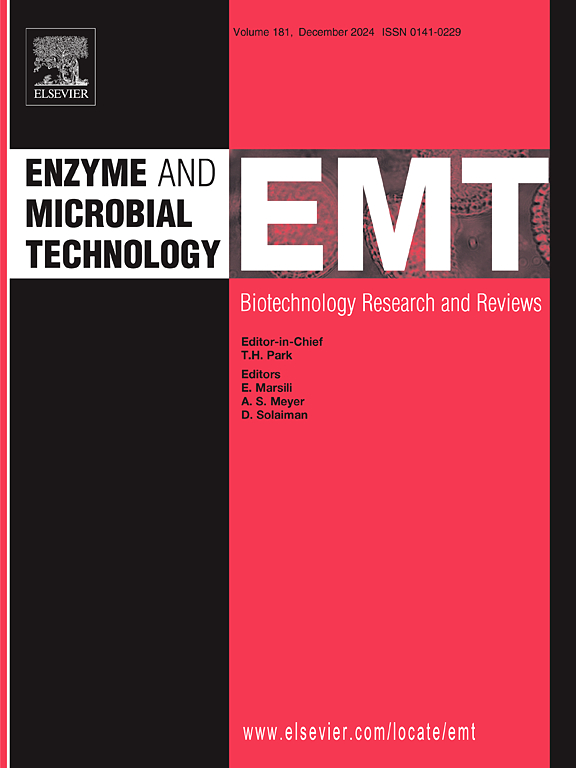Preparation of magnetic xylanase cross-linked aggregates (m-CLXAs) for the hydrolysis of arabinoxylan by mechano-enzymology
IF 3.7
3区 生物学
Q2 BIOTECHNOLOGY & APPLIED MICROBIOLOGY
引用次数: 0
Abstract
The development of a biocatalyst consisting of immobilised xylanases as cross-linked enzyme aggregates (CLEAs) on magnetic nanoparticles (MNPs) as support was undertaken. MNPs were prepared by a coprecipitation reaction of Fe3 + and Fe2+, followed by surface modification with (3-aminopropyl)-trimethoxysilane using a polycondensation reaction. Magnetic CLEAs were prepared via glutaraldehyde cross-linking after precipitation with acetone, and the physicochemical characterisation of the immobilised enzyme was performed at all stages using several techniques (FTIR, PXRD, TGA, and DLS). A one-factor-at-a-time approach (OFAT) was used to investigate the impact of temperature, time, enzyme: MNP ratio, precipitant, and cross-linking agent to determine their effect on the enzyme’s recovered activity. The results demonstrated that all parameters impacted the immobilisation differently, with the optimised conditions determined as 4°C, 12 h, 10 mg/g, 60 % (v/v) acetone, and 200 mM glutaraldehyde, respectively. The immobilisation did not affect the pH and temperature optima of the enzyme, which were 6.0 and 50–70°C, respectively, for both the free and immobilised enzymes. In contrast, the immobilised enzyme could be reused more than ten times to hydrolyse wheat arabinoxylan, without losing 50 % of its initial activity. Values for Vmax and Km only decreased slightly compared to those obtained for the free enzyme. The thermal inactivation parameters showed that the immobilisation procedure did not adversely affect the enzyme's catalytic properties after immobilisation. Finally, we assessed the immobilised enzyme for its ability to catalyse reactions under mechanochemical conditions (grinding and ageing) and found that the free and immobilised enzymes were active during solvent-free and liquid-assisted grinding (LAG).
机械酶水解阿拉伯木聚糖的磁性木聚糖酶交联聚集体(m-CLXAs)制备。
开发了一种由固定化木聚糖酶作为交联酶聚集体(CLEAs)在磁性纳米颗粒(MNPs)上作为支撑的生物催化剂。采用Fe3 +和Fe2+共沉淀法制备MNPs,再用(3-氨基丙基)-三甲氧基硅烷进行缩聚改性。用丙酮沉淀后,通过戊二醛交联制备了磁性clea,并使用FTIR、PXRD、TGA和DLS等技术对固定化酶进行了各阶段的理化表征。采用单因素一次法(OFAT)研究温度、时间、酶:MNP比、沉淀剂和交联剂对酶恢复活性的影响。结果表明,各参数对固定化效果的影响不同,最佳条件分别为4℃、12 h、10 mg/g、60 % (v/v)丙酮和200 mM戊二醛。固定不影响酶的最佳pH值和温度,游离酶和固定酶的最佳温度分别为6.0°C和50-70°C。相比之下,固定化酶可以重复使用10次以上来水解小麦阿拉伯木聚糖,而不会失去其初始活性的50% %。与游离酶相比,Vmax和Km值仅略有下降。热失活参数表明,固定化过程对固定化后酶的催化性能没有不利影响。最后,我们评估了固定化酶在机械化学条件下(研磨和老化)催化反应的能力,发现游离酶和固定化酶在无溶剂和液体辅助研磨(LAG)期间具有活性。
本文章由计算机程序翻译,如有差异,请以英文原文为准。
求助全文
约1分钟内获得全文
求助全文
来源期刊

Enzyme and Microbial Technology
生物-生物工程与应用微生物
CiteScore
7.60
自引率
5.90%
发文量
142
审稿时长
38 days
期刊介绍:
Enzyme and Microbial Technology is an international, peer-reviewed journal publishing original research and reviews, of biotechnological significance and novelty, on basic and applied aspects of the science and technology of processes involving the use of enzymes, micro-organisms, animal cells and plant cells.
We especially encourage submissions on:
Biocatalysis and the use of Directed Evolution in Synthetic Biology and Biotechnology
Biotechnological Production of New Bioactive Molecules, Biomaterials, Biopharmaceuticals, and Biofuels
New Imaging Techniques and Biosensors, especially as applicable to Healthcare and Systems Biology
New Biotechnological Approaches in Genomics, Proteomics and Metabolomics
Metabolic Engineering, Biomolecular Engineering and Nanobiotechnology
Manuscripts which report isolation, purification, immobilization or utilization of organisms or enzymes which are already well-described in the literature are not suitable for publication in EMT, unless their primary purpose is to report significant new findings or approaches which are of broad biotechnological importance. Similarly, manuscripts which report optimization studies on well-established processes are inappropriate. EMT does not accept papers dealing with mathematical modeling unless they report significant, new experimental data.
 求助内容:
求助内容: 应助结果提醒方式:
应助结果提醒方式:


